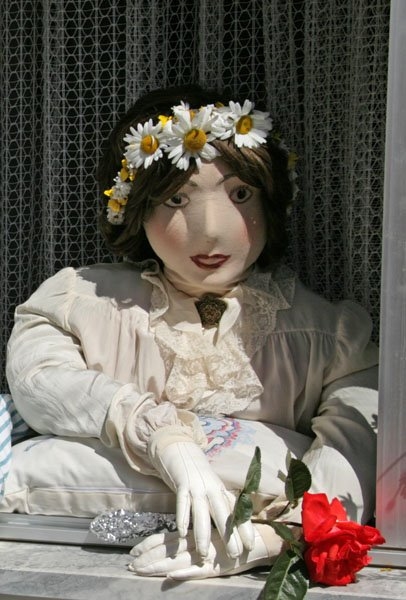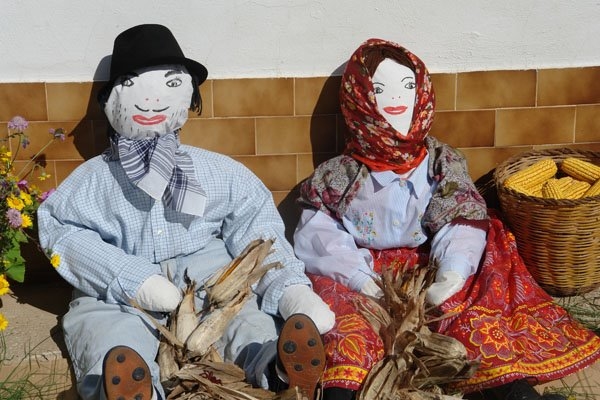As Maias


A origem da tradição das Maias perde-se no tempo. Segundo alguns, a Maia era uma boneca de palha de centeio, em torno da qual se dançava durante toda a noite do primeiro dia de Maio. Ritual ligado aos ritos da fertilidade, do início da Primavera e do novo ano agrícola.
Com o advento do Cristianismo atribuiu-se a este velho ritual pagão um carácter religioso. A lenda alusiva a esta tradição, que com mais frequência se ouve, reza assim: Herodes soube que a Sagrada Família, na sua fuga para o Egipto, pernoitaria numa certa aldeia. Para garantir que conseguiria eliminar o Menino, Herodes dispunha-se a mandar matar todas as crianças. Perante a possibilidade de um tão significativo morticínio, foi informado, por um outro "Judas", que tal poderia ser evitado, bastando para isso, que ele próprio colocasse um ramo de giesta florida na casa onde se encontrava a Sagrada Família, constituindo um sinal para que os soldados a procurassem e consumassem o crime... A proposta foi aceite e Herodes tratou de mandar os seus soldados à procura da tal casa. Qual não foi o espanto dos soldados quando, na manhã seguinte, encontraram todas as casas da aldeia com ramos de giesta florida à porta, gorando-se, assim, a possibilidade do Menino Jesus ser morto. Daí terá vindo essa tradição de colocar ramos e giestas nas portas e janelas das casas, na véspera do 1º de Maio.
Quase todas as tradições populares recorrem à gastronomia, especialmente à doçaria, como forma de preservar e evocar essas memórias. No Algarve podemos encontrar o “queijinho de Maio”, um bolo cerimonial confeccionado na altura em que o figo é colhido e seco. É feito com camadas alternadas de figo e massa de amêndoa, sendo encetado apenas no dia 1 de Maio.
Este evento, tão arreigado às gentes de Lagos – que no quinto mês do ano davam grandes passeios às hortas e às praias, folgando e festejando, com a natural jovialidade e alegria que caracteriza os algarvios –, coincidiu durante muitos anos com o feriado municipal de Lagos e mesmo quando o deixou de ser (passou para 27 de Outubro) a tradição de celebrar o Maio manteve-se. O indispensável “desarrolhar do Maio” consistia em saborear uns bolos de amêndoa ou uns figos torrados, não faltando a habitual aguardente de medronho, quer provenientes dos farnéis dos celebrantes, quer oferecidos nas casas que se visitavam para apreciar as Maias, sobretudo nas zonas rurais.
Se por cá passarem em Maio, apreciem as “Maias”, os queijos de Figo, o medronho e, claro, as vistas…


ENG
The origin of the “Maias” tradition was lost in time. According to some, the “Maias” were dolls fill with rye straw, around which people danced all night the first day of May. Ritual linked to rites of fertility, early spring and the new agricultural year.
The advent of Christianity gave to this old pagan ritual a religious character. The legend alluding to this tradition, which is more often told, is: Herod knew that the Holy Family in their escape to Egypt stayed in a certain village. To ensure that the child would be eliminated, Herod had to send people to kill all children. Given the significant possibility of such a killing, he was told by another "Judas", this could be avoided, simply, that he put a sprig flowering (Portuguese broom) in the house where the Holy Family was. This was a sign for soldiers to seek and to consummate the crime ... The proposal was accepted and Herod tried to send their soldiers in search of that house. What was the astonishment of the soldiers when the next morning, found all the village houses with branches of flowering broom at the door, frustrate, therefore, the possibility of the Child Jesus be killed. And so begin the tradition of placing branches of flowering broom on the doors and windows of houses on the eve of May 1.
Almost all popular traditions resort to food, especially sweets, as a way to preserve and recall those memories. In the Algarve we can find the "queijinhos de Maio", a ceremonial cake prepared at the time that the fig is harvested and dried. It is made with alternating layers of fig and almond paste, and is made to be eaten on May 1.
This event is ingrained on the people of Lagos – in the fifth month of the year people had great walks to country side and beaches, partying and celebrating with the natural joviality and joy that characterizes the Algarve inhabitants - for many years coincided with the Lagos bank holiday and even when no longer (it went to 27 October) the tradition of celebrating May remained. The indispensable "uncorking of May" was to enjoy a few almond cakes or roasted figs, together with the usual “schnapps”, either from the progs of celebrants, or offered in homes that they were visiting to see the “Maias”, especially in rural areas.
If you pass by in May, please enjoy the “Maias”, the fig cakes, the schnapps and, of course, the views…